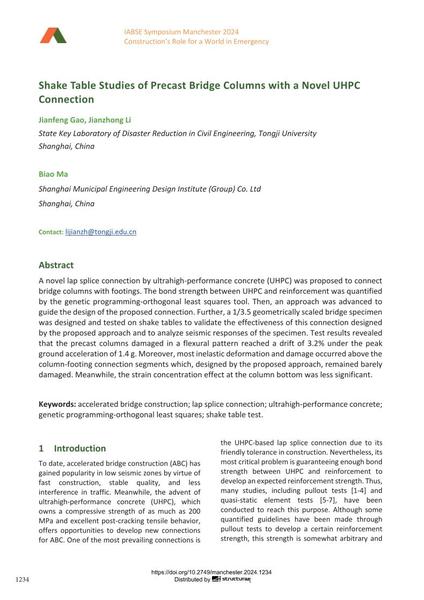Shake Table Studies of Precast Bridge Columns with a Novel UHPC Connection

|
|
|||||||||||
Bibliographic Details
| Author(s): |
Jianfeng Gao
(State Key Laboratory of Disaster Reduction in Civil Engineering, Tongji University Shanghai, China)
Jianzhong Li (State Key Laboratory of Disaster Reduction in Civil Engineering, Tongji University Shanghai, China) Biao Ma (Shanghai Municipal Engineering Design Institute (Group) Co. Ltd Shanghai, China) |
||||
|---|---|---|---|---|---|
| Medium: | conference paper | ||||
| Language(s): | English | ||||
| Conference: | IABSE Symposium: Construction’s Role for a World in Emergency, Manchester, United Kingdom, 10-14 April 2024 | ||||
| Published in: | IABSE Symposium Manchester 2024 | ||||
|
|||||
| Page(s): | 1234-1242 | ||||
| Total no. of pages: | 9 | ||||
| DOI: | 10.2749/manchester.2024.1234 | ||||
| Abstract: |
A novel lap splice connection by ultrahigh-performance concrete (UHPC) was proposed to connect bridge columns with footings. The bond strength between UHPC and reinforcement was quantified by the genetic programming-orthogonal least squares tool. Then, an approach was advanced to guide the design of the proposed connection. Further, a 1/3.5 geometrically scaled bridge specimen was designed and tested on shake tables to validate the effectiveness of this connection designed by the proposed approach and to analyze seismic responses of the specimen. Test results revealed that the precast columns damaged in a flexural pattern reached a drift of 3.2% under the peak ground acceleration of 1.4 g. Moreover, most inelastic deformation and damage occurred above the column-footing connection segments which, designed by the proposed approach, remained barely damaged. Meanwhile, the strain concentration effect at the column bottom was less significant. |
||||
| Keywords: |
shake table test accelerated bridge construction ultrahigh-performance concrete lap splice connection genetic programming-orthogonal least squares
|
||||
